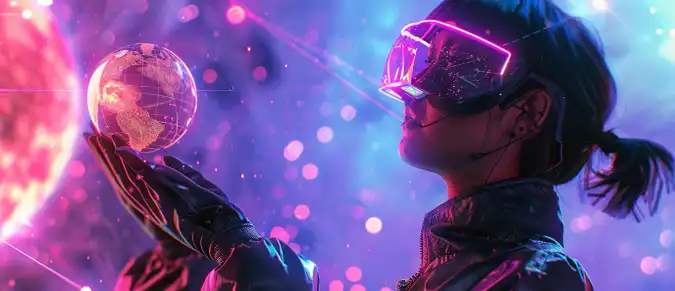Bloomverse is an ambitious blockchain-based game and an emerging metaverse that combines gameplay, social mechanics, digital ownership, and a sustainable economic model. The project aims to move beyond the familiar Play-to-Earn framework by creating an environment where value is formed naturally through player participation: building, exploration, trading, and generating unique content. Bloomverse treats the virtual world as a living digital organism that evolves through community interaction and long-term economic development.
Contents
- Bloomverse Concept and Metaverse Features
- Gameplay and Player Roles in the Digital World
- Bloomverse Economic Model and Tokenomics
- NFT and Digital Ownership: Structure and Utility
- Community and Project Development Prospects
- Conclusion

1. Bloomverse Concept and Metaverse Features
Bloomverse is an interactive metaverse project where the virtual world is not restricted by pre-defined boundaries. Unlike traditional games, players here can not only complete tasks but also influence the development of the world: modifying locations, building infrastructure, forming social groups, and affecting the economy. Thus, the metaverse acts as a platform for creativity and collaboration rather than a simple environment for mission progression.
Conceptually, Bloomverse seeks to overcome the shortcomings of early crypto games, which focused solely on profit and lacked meaningful gameplay. The core principle here is “gameplay value first” — earning is a consequence of a player’s contribution, not the primary goal. The narrative and social components are just as important as the internal economy.
The Bloomverse world unites resources, territories, quest systems, user-generated content, and character progression tools. This makes the ecosystem self-developing: the more participants become involved, the faster and more diverse the metaverse evolves. The project is designed for long-term development, with new territories, gameplay mechanics, and social structures appearing as the community grows.
Bloomverse strives to create an environment where every part of the game world is logically and functionally connected. Regions evolve not automatically but through player actions, reinforcing the feeling of co-creation. A crucial aspect is the adaptive nature of the world — it responds to social and economic changes. This creates dynamics similar to real-life ecosystems.
2. Gameplay and Player Roles in the Digital World
The gameplay revolves around exploration, production, and social interaction. Each participant chooses their playstyle based on personal goals and preferences. Roles are not fixed — players may combine different strategies to create unique paths of progression.
Main player roles include:
- Explorer — discovers new territories, gathers rare materials, and uncovers hidden objects.
- Trader — analyzes market conditions, sets prices, and builds logistics and supply chains.
- Builder — constructs buildings, infrastructure, and useful objects that influence territory development.
- Community Organizer — leads groups, forms guilds, and manages cooperative activities.
Gameplay is designed so that roles depend on one another. Explorers provide resources, builders convert them into useful structures, traders connect players through marketplaces, and community organizers shape large-scale social activity. This interdependence creates both economic and social stability.
Bloomverse avoids linear progression, allowing players to return to earlier stages to optimize strategies. Cooperation is encouraged, as many tasks are easier in groups. Reputation plays an important role: social credibility affects trade, alliances, and privileges. Therefore, behavior and interactions have a direct impact on success.
3. Bloomverse Economic Model and Tokenomics
The Bloomverse economy is based on its native token, used for resource exchange, crafting items, purchasing NFTs, and participating in governance. Importantly, the token is not merely a withdrawal instrument — its functionality is integrated into gameplay, preventing inflation and speculative bubbles.
| Mechanism | Role in Ecosystem |
|---|---|
| Limited Token Supply | Maintains scarcity and protects token value |
| Token Burning in Transactions | Reduces circulating supply and stabilizes the economy |
| Demand Based on In-Game Utility | Ensures value forms through use rather than speculation |
| Resource Production and Crafting | Encourages trade and social cooperation |
The system is designed for long-term sustainability and reduced price volatility. Players can influence the economy through alliances and market activity. DAO governance allows token holders to participate in important decisions, making the economy a form of collective management.

4. NFT and Digital Ownership: Structure and Utility
In Bloomverse, NFTs represent core digital ownership assets. These include characters, rare items, buildings, territories, and user-created gameplay elements. Each NFT has a unique signature and can be traded or utilized in-game.
Territory ownership allows players to build infrastructure and set interaction rules for others. This turns ownership into a strategic resource rather than a simple collectible.
Bloomverse applies an economic model where digital assets have utility, value, and market liquidity. User creativity also drives NFT use: players can design unique structures and monetize them. Smart contract protection ensures secure and transparent transactions.
5. Community and Project Development Prospects
The community is the core element of Bloomverse. The developers actively interact with players and encourage their initiatives: in-game events, testing of new mechanics, collaborative projects, cultural activities, and the formation of guilds all contribute to shaping the dynamics of the internal world.
Development plans include:
- New biomes and territories;
- Expanded UGC tools;
- Cross-chain integrations;
- Advanced social and roleplay mechanics.
Community engagement plays a crucial role in shaping future updates and the overall direction of the project. The developers regularly hold AMA sessions, voting events, and open discussions, fostering a transparent and collaborative environment. Gradually expanding opportunities for content creators opens the path to an economy where users not only play, but also earn by producing valuable experiences for others. Thus, the project evolves as an open ecosystem built on cooperation.
6. Conclusion
Bloomverse represents a new model of blockchain gaming, where gameplay, social dynamics, and digital economy are interconnected. The developers have successfully combined exploratory gameplay, ownership systems, and meaningful in-game value creation, avoiding the pitfalls of early Play-to-Earn projects. The project aims to create a sustainable world in which players feel not like consumers, but like co-creators.
As the community grows, tools for creativity expand, and new game mechanics are integrated, Bloomverse has the potential to become a benchmark for the next generation of metaverses. Its value lies in building a world where player actions have real impact and leave a lasting mark on the development of the digital ecosystem.




